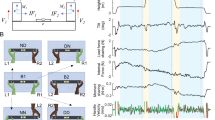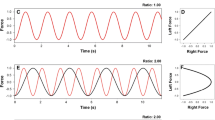Abstract
The present study aimed to determine the effects of force asymmetry on interpersonal force production. This study consisted of an individual task executed by one participant at a time in a pair, and three joint tasks executed by two participants simultaneously under conditions of 1:1, 1:0.75, and 1:0.5. Two individuals produced discrete forces at the same time so that the sum of forces they produced was the target force in the joint task. Under the 1:1 condition, the target force was the sum of the maximum voluntary contraction (MVC) produced by the index finger of each participant × 0.1 (10% MVC). Under the 1:0.75 condition, the investigators manipulated the force produced by only one of the pair, for example, B, but not A. The feedback was also scaled as a result. The target force was the MVC of participant A + the MVC of participant B × 0.75 × 0.1. Similarly, the target force under the 1:0.5 condition was the MVC of participant A + the MVC of participant B × 0.5 × 0.1. The present study found that forces produced by pairs were negatively correlated and the correlation value was higher under the 1:1 condition than the 1:0.75 and 1:0.5 conditions. The absolute error was smaller under the 1:1 condition than the 1:0.5 condition. Complementary force production was attenuated and the error increased as differences between forces produced by two participants increased. Thus, asymmetry of forces produced by pairs deteriorated complementary force production and interpersonal performance.




Similar content being viewed by others
References
Bosga J, Meulenbroek RGJ (2007) Joint-action coordination of redundant force contributions in a virtual lifting task. Mot Control 11:235–258
Clark H (1996) Using language. Cambridge University Press, Cambridge, p 83
Ganesh G, Takagi A, Osu R, Yoshioka T, Kawato M, Burdet E (2014) Two is better than one: physical interactions improve motor performance in humans. Sci Rep 4:3824
Knoblich G, Jordan JS (2003) Action coordination in groups and individuals: learning anticipatory control. J Exp Psychol Learn Mem Cogn 29:1006–1016
Konvalinka I, Vuust P, Roepstorff A, Frith CD (2010) Follow you, follow me: continuous mutual prediction and adaptation in joint tapping. Q J Exp Psychol 63:2220–2230
Loehr DJ, Vesper C (2016) The sound of you and me: novices represent shared goals in joint action. Quart J Exp Psychol 69:536–547
Loehr JD, Kourtis D, Vesper C, Sebanz N, Knoblich G (2013) Monitoring individual and joint action outcomes in duet music performance. J Cogn Neurosci 25:1049–1061
Masumoto J, Inui N (2013) Two heads are better than one: both complementary and synchronous strategies facilitate joint action. J Neurophysiol 109:1307–1314
Masumoto J, Inui N (2014a) A leader–follower relationship in joint action on a discrete force production task. Exp Brain Res 232:3525–3533
Masumoto J, Inui N (2014b) Effects of speech on both complementary and synchronous strategies in joint action. Exp Brain Res 232:2421–2429
Masumoto J, Inui N (2015) Motor control hierarchy in joint action that involves bimanual force production. J Neurophysiol 113:3736–3743
Masumoto J, Inui N (2019) Load perturbation facilitates interpersonal error compensation in a dyadic force production task. J Mot Behav 51:59–67
Noy L, Dekel E, Alon U (2011) The mirror game as a paradigm for studying the dynamics of two people improvising motion together. Proc Natl Acad Sci USA 108:20947–20952
Oldfield RC (1971) The assessment and analysis of handedness: the Edinburgh inventory. Neuropsychologia 9:97–113
Reed K, Peshkin M, Hartmann MJ, Graboweeky M, Patton J, Vishton PM (2006) Haptically linked dyads are two motor-control systems better than one? Psychol Sci 17:365–366
Schmidt RA, Zelaznik H, Hawkins B, Frank JS, Quinn JT (1979) Motor-output variability: a theory for the accuracy of rapid motor acts. Psychol Rev 86:415–451
Sebanz N, Knoblich G (2009) Prediction in joint action: what, when, and where. Top Cogn Sci 1:353–367
Sebanz N, Bekkering H, Knoblich G (2006) Joint action: bodies and minds moving together. Trends Cogn Sci 10:70–76
van der Wel RPRD, Knoblich G, Sebanz N (2011) Let the force be with us: dyads exploit haptic coupling for coordination. J Exp Psychol Hum Percept Perform 37:1420–1431
Wahn B, Karlinsky A, Schmitz L, Konig P (2018) Let’s move it together: a review of group benefits in joint object control. Front Psychol 9:918
Wolpert DM, Doya K, Kawato M (2003) A unifying computational framework for motor control and social interaction. Philos Trans R Soc Lond B Biol Sci 358:593–602
Acknowledgements
This study was supported by the Japan Society for the Promotion of Science (18K17911).
Author information
Authors and Affiliations
Corresponding author
Additional information
Publisher's Note
Springer Nature remains neutral with regard to jurisdictional claims in published maps and institutional affiliations.
Rights and permissions
About this article
Cite this article
Masumoto, J., Inui, N. Force asymmetry deteriorates complementary force production during joint action. Exp Brain Res 237, 1833–1839 (2019). https://doi.org/10.1007/s00221-019-05555-6
Received:
Accepted:
Published:
Issue Date:
DOI: https://doi.org/10.1007/s00221-019-05555-6




